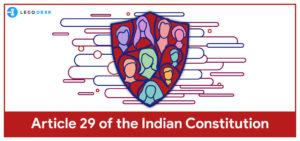Article 29 of the Indian Constitution

Introduction
A certain part of the Indian population has remained suppressed since centuries. This differentiation in the population may be created by religion, caste, sex, language, etc. In order to provide aid to the oppressed society, the Drafting Committee had attempted to incorporate some provisions which create positive discrimination with respect to such part of the society. Some of this provision include Article 15, Article 16, Article 17, etc. Article 29 and 30 in particular deal with the Cultural and Educational rights of an individual. Likewise, Article 29 of the Indian Constitution provides for the fundamental right of protection of language and culture of such minorities.
Read Also: Article 26 of the Indian Constitution
What is Minority?
The term ‘minorities’ has not been defined in our constitution. The Constituent Assembly, through its various debates, summarized the meaning of ‘minorities’ in terms of the numerical representation of a community in a particular state. However, no proper definition was provided for the same.
At present, the minority is determined on two bases, i.e., religion and language. For the purpose of determining minority, the unit will be the state and not the whole of India. Minorities have to be considered State-wise since the reorganization of the states of India was made on linguistic lines. It is a relative term and is referred to represent the linguistic or religious sections or groups forming less than 50% of the total population of the State.[1] The same was upheld in A.M. Patroni v. Kesavan[2] and TMA Pai Foundation v. State of Karnataka[3].
Article 29: Protection of Minorities Interest
Article 29 confers rights on minorities to conserve their language and culture. It does not impose any positive obligation on the State to take any action to conserve any culture or language. It merely enables a cultural or linguistic minority to preserve its own culture or language and bars the State from imposing on it any other language or culture.
Clause 1 of Article 29 gives protection to the citizens having a distinct language, script, culture, and provide them with the right to conserve the same. In addition to this, the clause 2 of Article 29 states that no citizen shall be denied admission into any educational institution maintained by the State or receiving aid out of State funds on grounds only of religion, race, caste, language or any of them.
Judicial Perspective
English Medium Student Association vs. the State of Karnataka
In the case of English Medium Students Parents Association vs. State of Karnataka[4], the essence of Article 29(1) was ascertained. The Court focused on the importance of preserving the mother tongue of people and stated that pupils should begin their schooling through the medium of their mother tongue. The main reason behind it is the fact that basic knowledge can be granted only through native language. Moreover, the involvement of foreign language during the tender age of children makes the education process artificial and torturous.
Guru Nanak University Case
Likewise, the Supreme Court in Guru Nanak University Case[5] has held that a university has a right to provide for the education of the majority in the regional medium. Although, it cannot restrain the language and script of any section of the Indian population. If it does so, then the right of such citizens to conserve their language or script through educational institutions of their own is stifled, and this is unconstitutional.
St. Stephen’s College vs. Union of Delhi
In furtherance of Article 29(2) the Supreme Court in St. Stephen’s College vs. Union of Delhi[6], held that since the college was a minority institution, it has the right to admit students of own preference, but due to it being aided by the Government it cannot deny admission to students on the basis of religion. The court accordingly, instructed that a reservation for minority cannot be made for more than 50%.
DP Joshi vs. State of Madhya Bharat
However, one kind of discrimination still prevails, and this has even been upheld by the Supreme Court in Joshi[7]. It is the use of residence qualification for admission to the State-aided educational institutions. As a requirement for admission to State medical colleges, an applicant should have studied for 10 years in the educational institutions in the State, has been upheld as not infringing Article 19(1)(d) and (e). A State can accord some preferential treatment to citizens domiciled or residing therein provided that it is not hit by Article 14. Recently, the Supreme Court has laid down that so far as admissions to postgraduate courses are concerned, it would be desirable not to provide reservation based on residence or institutional preference.[8]
Conclusion
The ascertainment of minorities was traditionally carried out numerically. However, the definition of the term minority has evolved with time. These minorities have been oppressed since the inception of society, and thus, the drafting committee has ensured their upliftment through a certain provision in the constitution.
[1] In re Kerala Education Bill, 1959, 1 SCR 995.
[2] 1971 AIR 1731.
[3] (2002) 8 SCC 482.
[4] 1994 AIR 1702.
[5] D.A.V. Jalandhar v. the State of Punjab, AIR 1971 SC 1737.
[6] 1992 AIR 1630.
[7] D. P. Joshi Vs. The State Of Madhya Bharat, 1955 AIR 334.
[8] Ashoka Kumar Thakur v. Union of India, (2008) 6 SCC 1.
Try our Debt Resolution solutions today Request a Demo